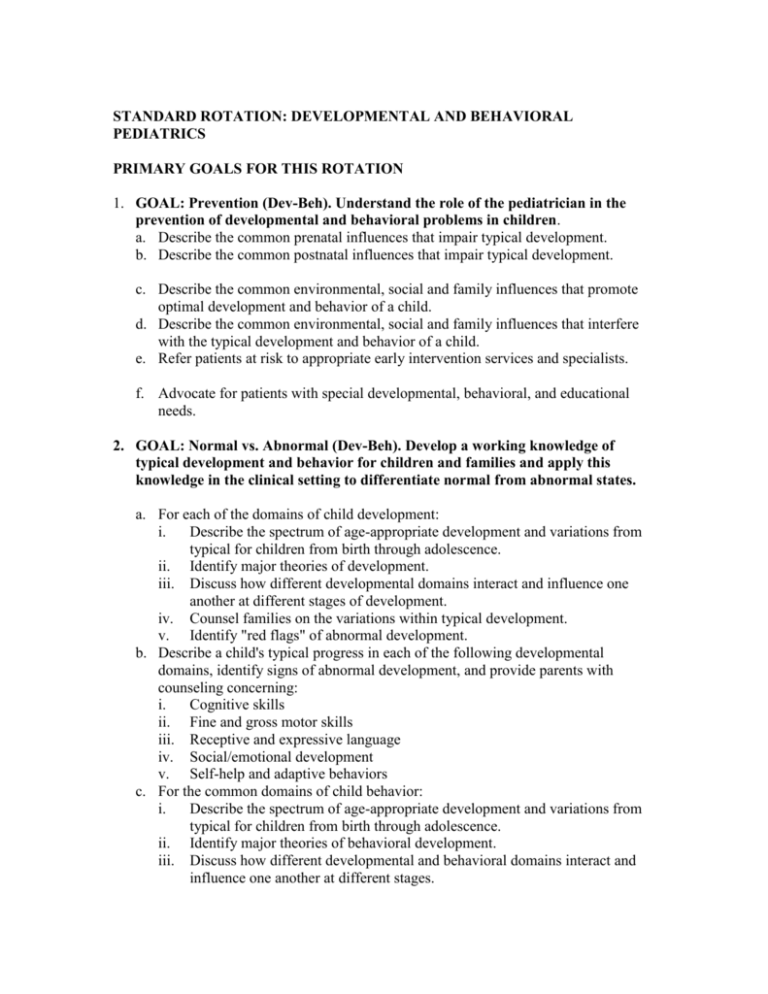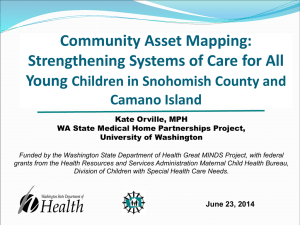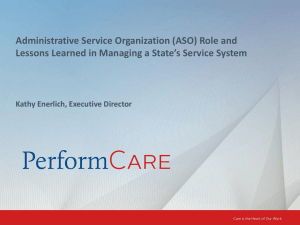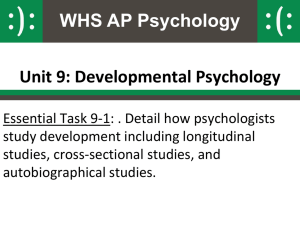Standard DB Pediatrics Rotation Goals per the APA
advertisement

STANDARD ROTATION: DEVELOPMENTAL AND BEHAVIORAL PEDIATRICS PRIMARY GOALS FOR THIS ROTATION 1. GOAL: Prevention (Dev-Beh). Understand the role of the pediatrician in the prevention of developmental and behavioral problems in children. a. Describe the common prenatal influences that impair typical development. b. Describe the common postnatal influences that impair typical development. c. Describe the common environmental, social and family influences that promote optimal development and behavior of a child. d. Describe the common environmental, social and family influences that interfere with the typical development and behavior of a child. e. Refer patients at risk to appropriate early intervention services and specialists. f. Advocate for patients with special developmental, behavioral, and educational needs. 2. GOAL: Normal vs. Abnormal (Dev-Beh). Develop a working knowledge of typical development and behavior for children and families and apply this knowledge in the clinical setting to differentiate normal from abnormal states. a. For each of the domains of child development: i. Describe the spectrum of age-appropriate development and variations from typical for children from birth through adolescence. ii. Identify major theories of development. iii. Discuss how different developmental domains interact and influence one another at different stages of development. iv. Counsel families on the variations within typical development. v. Identify "red flags" of abnormal development. b. Describe a child's typical progress in each of the following developmental domains, identify signs of abnormal development, and provide parents with counseling concerning: i. Cognitive skills ii. Fine and gross motor skills iii. Receptive and expressive language iv. Social/emotional development v. Self-help and adaptive behaviors c. For the common domains of child behavior: i. Describe the spectrum of age-appropriate development and variations from typical for children from birth through adolescence. ii. Identify major theories of behavioral development. iii. Discuss how different developmental and behavioral domains interact and influence one another at different stages. d. e. f. g. h. i. j. iv. Counsel families on the variations within typical behavior. v. Diagnose "red flags" of abnormal behavior. Describe a child's typical progress in each of the following behavioral domains, identify signs of abnormal development, and provide parents with counseling concerning: i. Attachment (bonding) ii. Autonomy iii. Elimination iv. Eating v. Sexuality vi. Sleep vii. Temperament Counsel parents about typical parenting issues (related to child development, behavior, health and safety, family adjustment). Diagnose and manage specific pediatric behavioral, developmental and medical problems using knowledge and insight about family development and family systems theory. Recognize and differentiate between developmentally-appropriate coping strategies used by children and their families to contend with illness and medical interventions, and common ineffective coping strategies, including noncompliance. Use standardized, validated and accurate developmental and behavioral screening instruments, plus skills in interview, exam and medical knowledge to identify patterns of atypical development, such as: i. ADHD home and school questionnaires (e.g., Vanderbilt, Connors) ii. Behavioral screening questionnaire (e.g., Eyberg Child Behavior Inventory, Pediatric Symptom Check List, PEDS, ASQ-SE) iii. Developmental screening tools reliant on parental report (e.g., ASQ, PEDS, CDIs) iv. Developmental screening tools requiring direct elicitation and measurement of children's behavior (e.g. Brigance, Battelle, Bayley Infant Neurodevelopmental Screener, SWILS) v. Hearing screening (general, pure tone audiometry, otoacoustic emissions) vi. Language screening vii. Home and parent risk assessment tools to screen for social concerns, e.g., alcohol abuse, domestic violence, depression (e.g., Family Psychosocial Screen, Edinburgh Depression Inventory) Select, perform and/or interpret appropriate clinical tests to establish a medical etiology of identified developmental and/or behavioral problems, such as: i. Blood tests to rule out organic or genetic conditions (such as thyroid function, lead screen, genetic testing, metabolic screening) ii. Neuroimaging studies and others (such as head MRI) Demonstrate familiarity with commonly used clinical and psychoeducational testing used by specialists to evaluate and monitor children with developmental and behavioral problems. i. ii. iii. iv. Identify common measures of intelligence used with infants, preschool and school age children (e.g., WPPSI, WISC-III, K-ABC). Recognize common diagnostic measures of achievement, speech-language, and adaptive behavior (e.g., WRAT-R, Vineland Adaptive Behavior Scales, Preschool Language Scale-IV). Understand the meaning of quotients and percentiles, the range of possible scores, common averages and standard deviations. Know the scores typically observed in children with specific developmental conditions such as mental retardation, learning disabilities, giftedness, etc. 3. GOAL: Anticipatory Guidance (Dev-Beh). Provide appropriate anticipatory guidance related to common developmental and behavioral issues. a. Provide anticipatory guidance to parents about expected behaviors or milestones at a child's next developmental level. b. Provide anticipatory guidance to families about developmental aspects of injury prevention, common behaviors (i.e., feeding), discipline, and child's approach to the physical exam and interview. c. Provide anticipatory guidance, developmental promotion, and counseling for the following issues and problems: i. Adoption ii. Children at risk due to poverty, abuse or neglect, etc. iii. Behavioral management and positive disciplinary techniques iv. Normal independence seeking and limit testing behaviors v. Positive attention vi. Warnings and punishment vii. Day care viii. Death of a family member ix. Developmental disabilities, including transition needs from infancy through adolescence and young adulthood x. Divorce xi. Early intervention programs xii. Eating problems xiii. Exposure to violence xiv. Gifted children xv. Habits (thumb sucking and nail biting) xvi. Typical sleep patterns xvii. Parenting in a variety of settings, such as adoptive, foster, single parents, step or "blended" families, etc. xviii.Peer relationships and social skills xix. Resiliency xx. School success and failure xxi. Self-esteem xxii. Sexuality (typical patterns of sexual behavior, masturbation, sexual preference, sexually transmitted diseases, birth control) xxiii.Sibling rivalry xxiv. Sleep problems xxv. Substance abuse xxvi. Television, video, computer and media xxvii. Toilet training xxviii. Preschool and kindergarten readiness xxix. Study skills and home work assistance xxx. Promoting speech and language development xxxi. Literacy promotion xxxii. Separation issues xxxiii. Bullying 4. GOAL: Undifferentiated Signs and Symptoms (Dev-Beh). Evaluate and manage common developmental-behavioral signs and symptoms in infants, children, and adolescents. a. For developmental-behavioral signs and symptoms in infants, children, and adolescents: i. Perform an appropriate problem-oriented interview and physical examination. ii. Obtain additional information from other related sources (e.g., day care, school). iii. 3.29.1.3 :Formulate a differential diagnosis, including typical variants where appropriate. iv. Use structured screening instruments as appropriate. v. Formulate and carry out a plan for evaluation. vi. Develop a management plan with the patient and family. vii. Demonstrate effective communication to insure accurate history-taking, patient and family understanding, mutual decision-making, and adherence to therapy. viii. Provide appropriate follow-up, including case management, when multiple disciplines are involved. b. Evaluate and manage the following developmental-behavioral signs and symptoms, provide appropriate counseling to parents or patients, and identify appropriate referral resources: i. Inattention ii. Hyperactivity iii. Delay in a single developmental domain iv. Delay in multiple developmental domains v. Sleep disturbances vi. Elimination disturbances vii. Feeding disturbances viii. Poor academic performance ix. Loss of developmental milestones x. Regression of behavioral self-control xi. Excessive out-of-control behaviors (e.g., anger outbursts) xii. Abrupt change in eating, sleeping, and/or socialization xiii. Anxiety xiv. Depressed affect xv. Grief xvi. Sexual orientation issues xvii. Gender identity issues xviii.Somatic complaints xix. Obsessive-compulsive symptoms xx. Separation anxiety xxi. Tics xxii. Somatic complaints xxiii.Violence xxiv. Excessive concerns about body image 5. GOAL: Common Conditions Not Referred (Dev-Beh). Recognize and manage common developmental and behavioral conditions that generally do not require referral. a. For the common developmental-behavioral problems commonly observed in infants, children, and adolescents: i. Describe diagnostic criteria, applying DSM-PC codes that determine variation, problem, or condition. ii. Discuss environmental and biologic risk factors. iii. Explain alternative or co-morbid conditions. iv. Describe natural history and common variations. v. Implement assessment appropriate to the primary care setting, including input from home, school and other environments as necessary. vi. Implement individualized case management. vii. Counsel parents in age-appropriate intervention. viii. Describe indications for referral to other professionals for evaluation or treatment. ix. Execute appropriate referrals to mental health and other professionals and other community resources. b. Recognize and manage, and counsel parents and patients concerning the following common developmental and behavioral problems that do not generally require referral: i. Adjustment reactions ii. Attention deficit hyperactivity disorder, uncomplicated iii. Breath-holding spells iv. Physiologic crying in infancy and colic v. Oppositional behavior vi. Difficulties with parenting and discipline vii. Encopresis viii. Enuresis ix. Failure to thrive x. Fears and anxiety xi. Habits (nail biting, hair twirling, etc.) xii. School avoidance/refusal xiii. Sleep-wake cycle disturbances xiv. Stress reactions xv. Temper tantrums xvi. Head banging xvii. Simple motor tic xviii.Typical separation anxiety xix. Functional pain xx. Mild depression 6. GOAL: Common Conditions Generally Referred (Dev-Beh). Recognize, provide initial management, appropriately refer, and provide primary care case management for common developmental or behavioral conditions that often need additional diagnostic and/or management support from other specialties or disciplines. a. For the more complex developmental-behavioral problems that require referral for diagnostic or management support: i. Describe diagnostic criteria. ii. Discuss environmental and biologic risk factors. iii. Identify alternative or co-morbid conditions. iv. Describe natural history. v. Organize initial assessment, consultation, and ongoing management as the primary care pediatrician. b. Recognize, provide initial management, appropriately refer and provide primary care case management for the following developmental-behavioral conditions: i. Developmental-behavioral disorders associated with chronic physical health conditions (e.g., spina bifida, cleft lip, cleft palate, paraplegia, amputation, sensory impairment, Tourette's disorder, prematurity) ii. Cognitive disabilities (e.g., mental retardation) iii. Language and learning disabilities iv. Motor disabilities (e.g., cerebral palsy, muscular dystrophy) v. Autistic spectrum disorders vi. Attention problems, moderate to severe vii. Externalizing disorders (e.g., violence, conduct disorder, antisocial behavior, oppositional defiant disorder, school failure, school phobia, excessive school absences, firesetting) viii. Internalizing disorders (e.g., adjustment disorder, anxiety disorder, conversion reactions, somatoform disorders, depression, mood disorders, suicide contemplation or attempt, PTSD) ix. Substance abuse x. Social and environmental morbidities (e.g., physical abuse, sexual abuse, parental health disorders such as depression and substance abuse) xi. Problems of feeding, eating, elimination, sleep xii. Atypical behaviors (e.g., post traumatic stress disorder, psychosis) xiii. Problems of gender identity, sexuality, or related issues xiv. Psychosis/Schizophrenia, borderline personality c. Serve as case manager or active team participant for individuals with developmental and behavioral disorders through the primary care setting, demonstrating skills including, but not limited to: i. Communication and record-sharing with other disciplines ii. Maintenance of a complete problem list iii. Managing the "whole patient" iv. Family empowerment and communication v. Maintain patient and family confidentiality (HIPAA) d. Discuss interventions and specialists that assist with the diagnosis or ongoing management of children with developmental-behavioral disorders, demonstrate knowledge of referral sources, and demonstrate ability to work collaboratively with a variety of these professionals. i. Audiologist ii. Behavior modification specialists iii. Child Life iv. Child psychiatry v. Child psychology vi. Community resources/support systems (Boys and Girls club, Family Resource Centers) vii. Developmental-behavioral pediatrician viii. Early intervention services ix. Educational intervention (preschool and school age) x. Family counseling xi. Feeding specialists xii. Hypnosis, relaxation, and self-control techniques xiii. Interdisciplinary team for evaluation xiv. Neurodevelopmental pediatrician xv. Pediatric neurology xvi. Occupational therapy xvii. Physical therapy xviii.Physical medicine and rehabilitation xix. Pharmacotherapy xx. Social work services xxi. Speech and language therapy xxii. Teachers xxiii.Vision specialist xxiv. Other (play therapy, music therapy, support groups, parent training, etc.) 7. GOAL: Pediatric Competencies in Brief (Dev-Beh). Demonstrate high standards of professional competence while working with children who present with developmental and behavioral concerns. [For details see Pediatric Competencies.] a. Competency 1: Patient Care. Provide family-centered patient care that is development- and age-appropriate, compassionate, and effective for the treatment of health problems and the promotion of health. i. Use a logical and appropriate clinical approach to the care of children who present with developmental and behavioral concerns, applying principles of evidence-based decision-making and problem-solving. ii. b. c. d. e. f. Provide sensitive support to children who present with developmental and behavioral concerns, and their families. Competency 2: Medical Knowledge. Understand the scope of established and evolving biomedical, clinical, epidemiological and social-behavioral knowledge needed by a pediatrician; demonstrate the ability to acquire, critically interpret and apply this knowledge in patient care. i. Demonstrate a commitment to acquiring the knowledge needed in developmental and behavioral pediatrics. ii. Know and/or access medical information efficiently, evaluate it critically, and apply it appropriately to care of children and families dealing with developmental and behavioral concerns. Competency 3: Interpersonal Skills and Communication. Demonstrate interpersonal and communication skills that result in information exchange and partnering with patients, their families and professional associates. i. Communicate skillfully with families and children and provide appropriate patient education and reassurance for conditions common to developmental and behavioral pediatrics. ii. Communicate effectively with physicians, other health professionals, and health-related agencies to create and sustain information exchange and teamwork for patient care. iii. Maintain accurate, legible, timely, confidential and legally appropriate medical records in this clinical setting. Competency 4: Practice-based Learning and Improvement. Demonstrate knowledge, skills and attitudes needed for continuous self-assessment, using scientific methods and evidence to investigate, evaluate, and improve one's patient care practice. i. Use scientific methods and evidence to investigate, evaluate, and improve patient care practice related to developmental and behavioral issues. ii. Identify personal learning needs, systematically organize relevant information resources for future reference, and plan for continuing acquisition of knowledge and skills. Competency 5: Professionalism. Demonstrate a commitment to carrying out professional responsibilities, adherence to ethical principles, and sensitivity to diversity. i. Demonstrate personal accountability to the well-being of patients (e.g., following-up on lab results, writing comprehensive notes, and seeking answers to patient care questions). ii. Demonstrate a commitment to professional behavior in interactions with staff and professional colleagues. iii. Adhere to ethical and legal principles, and be sensitive to diversity. Competency 6: Systems-Based Practice. Understand how to practice high-quality health care and advocate for patients within the context of the health care system. i. Identify key aspects of health care systems as they apply to care of individuals and their families dealing with mental health, behavioral or developmental concerns, including cost control, billing, and reimbursement. ii. iii. iv. Demonstrate sensitivity to the costs of clinical care for patients who present with developmental or behavioral concerns, and take steps to minimize costs without compromising quality. Recognize and advocate for families who need assistance to deal with system complexities and identify resources to meet their needs. Recognize the limits of one's knowledge and expertise and take steps to avoid medical errors. PROCEDURES 1. GOAL: Diagnostic and screening procedures. Describe the following tests or procedures, including how they work and when they should be used; competently perform those commonly used by the pediatrician in practice. a. b. c. d. e. f. g. ADHD home and school questionnaires Audiometry evaluation: interpretation Behavioral screening questionnaire Developmental screening test Hearing screening Language screening test Vision screening SOURCE Kittredge, D., Baldwin, C. D., Bar-on, M. E., Beach, P. S., Trimm, R. F. (Eds.). (2004). APA Educational Guidelines for Pediatric Residency. Ambulatory Pediatric Association Website. Available online: www.ambpeds.org/egweb. [Accessed 11/11/2005]. Project to develop this website was funded by the Josiah Macy, Jr. Foundation 2002-2005.







